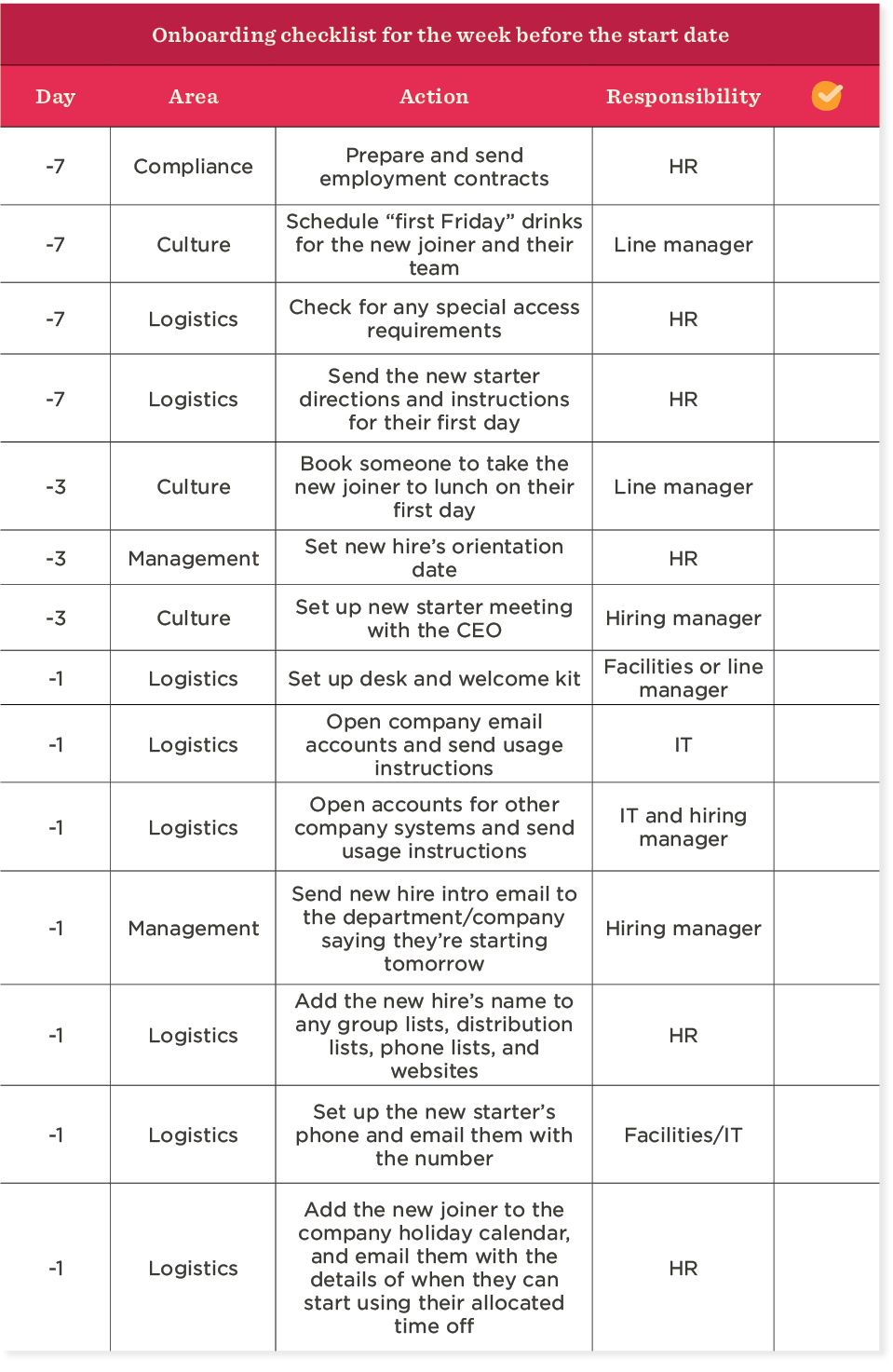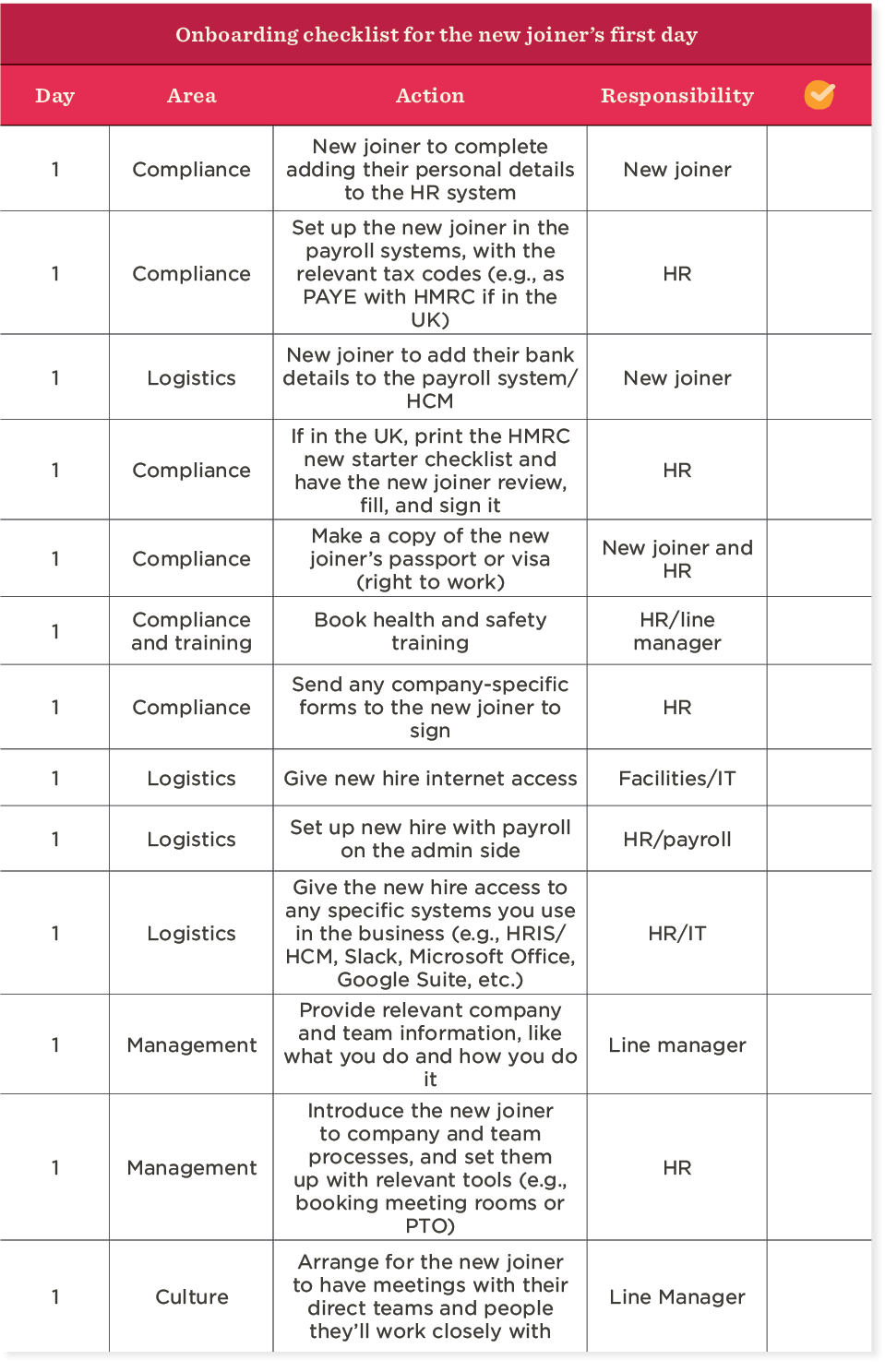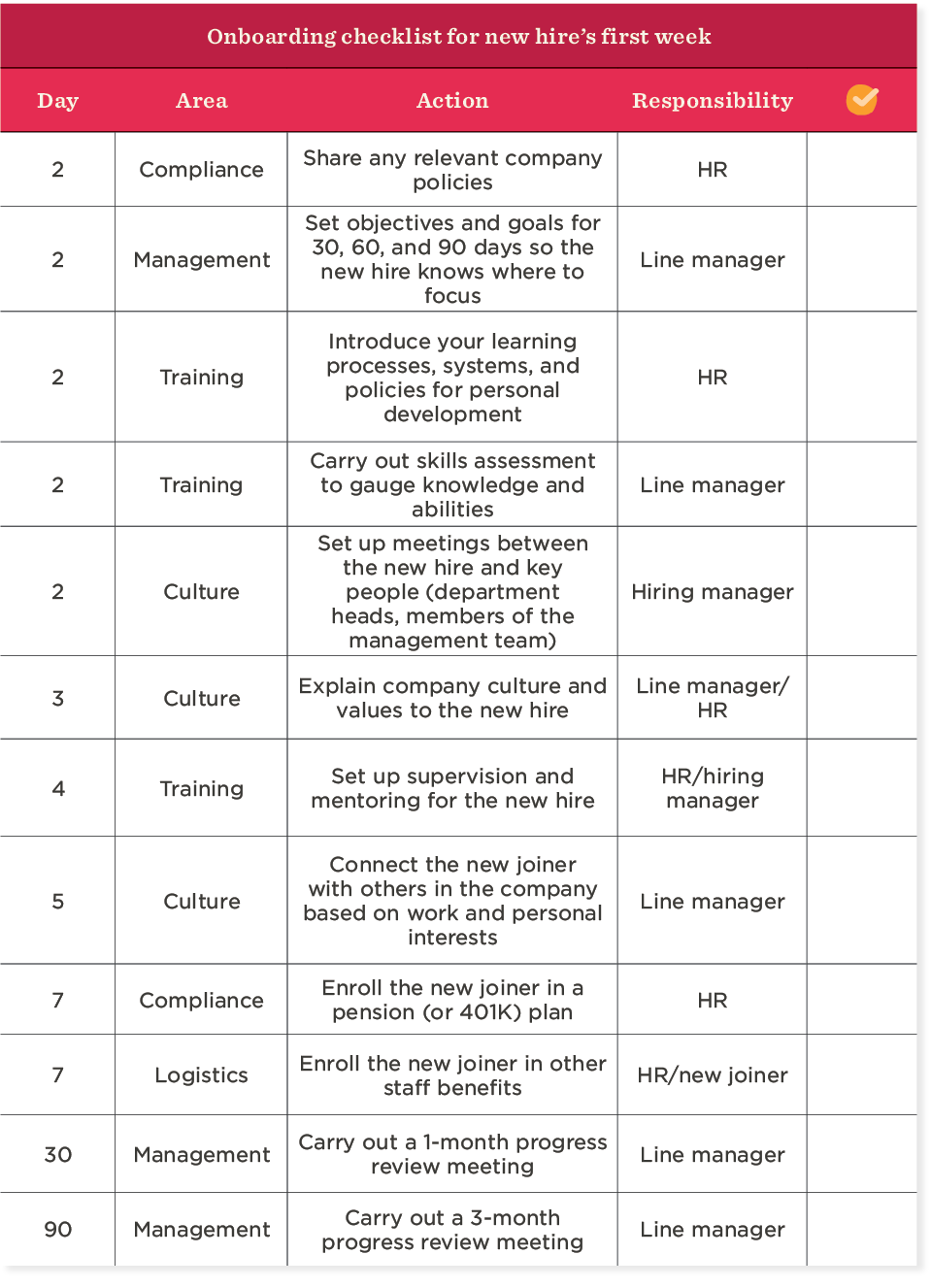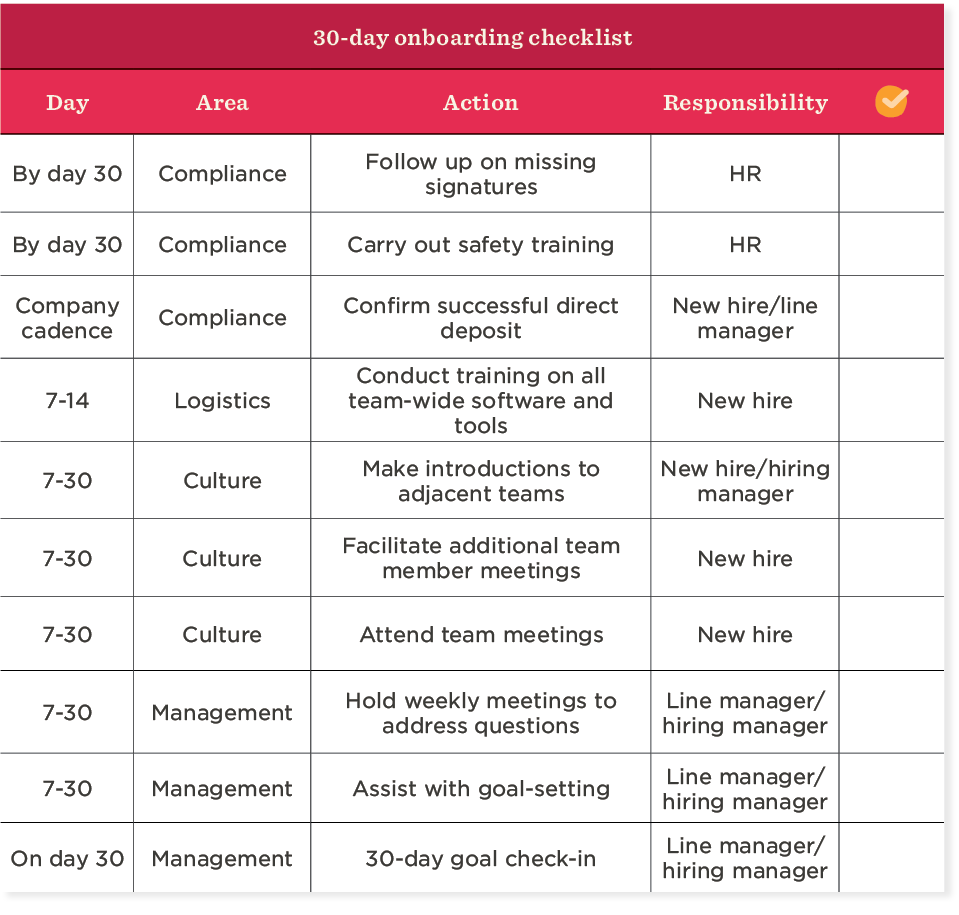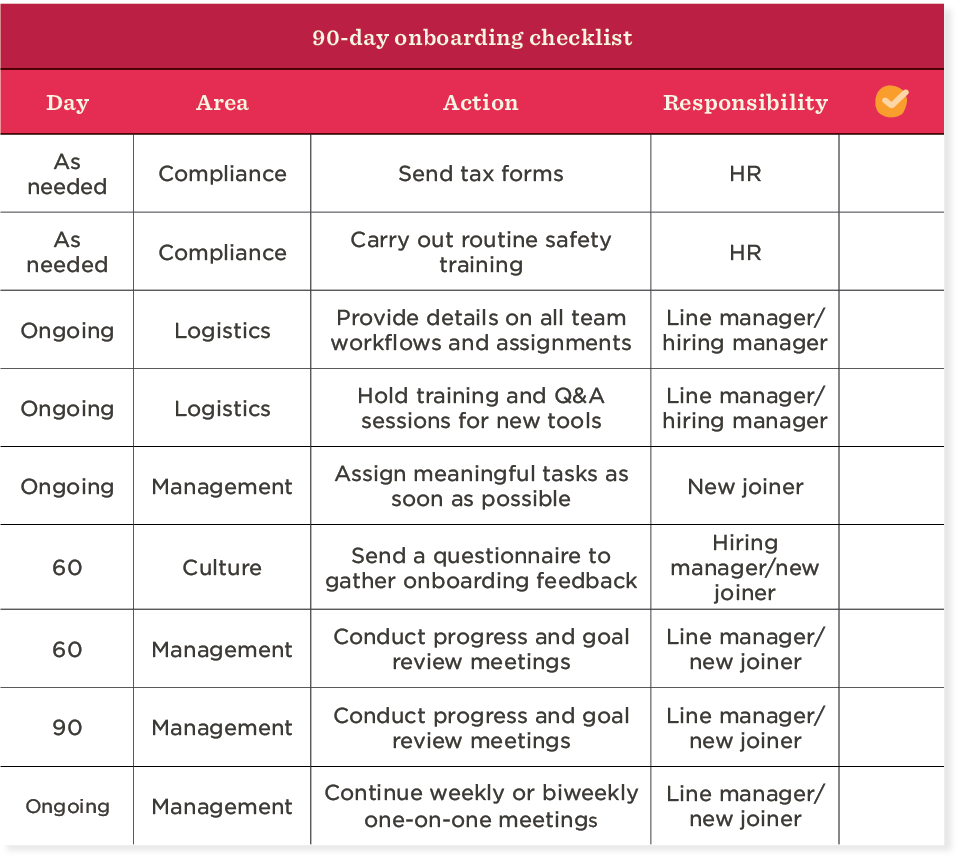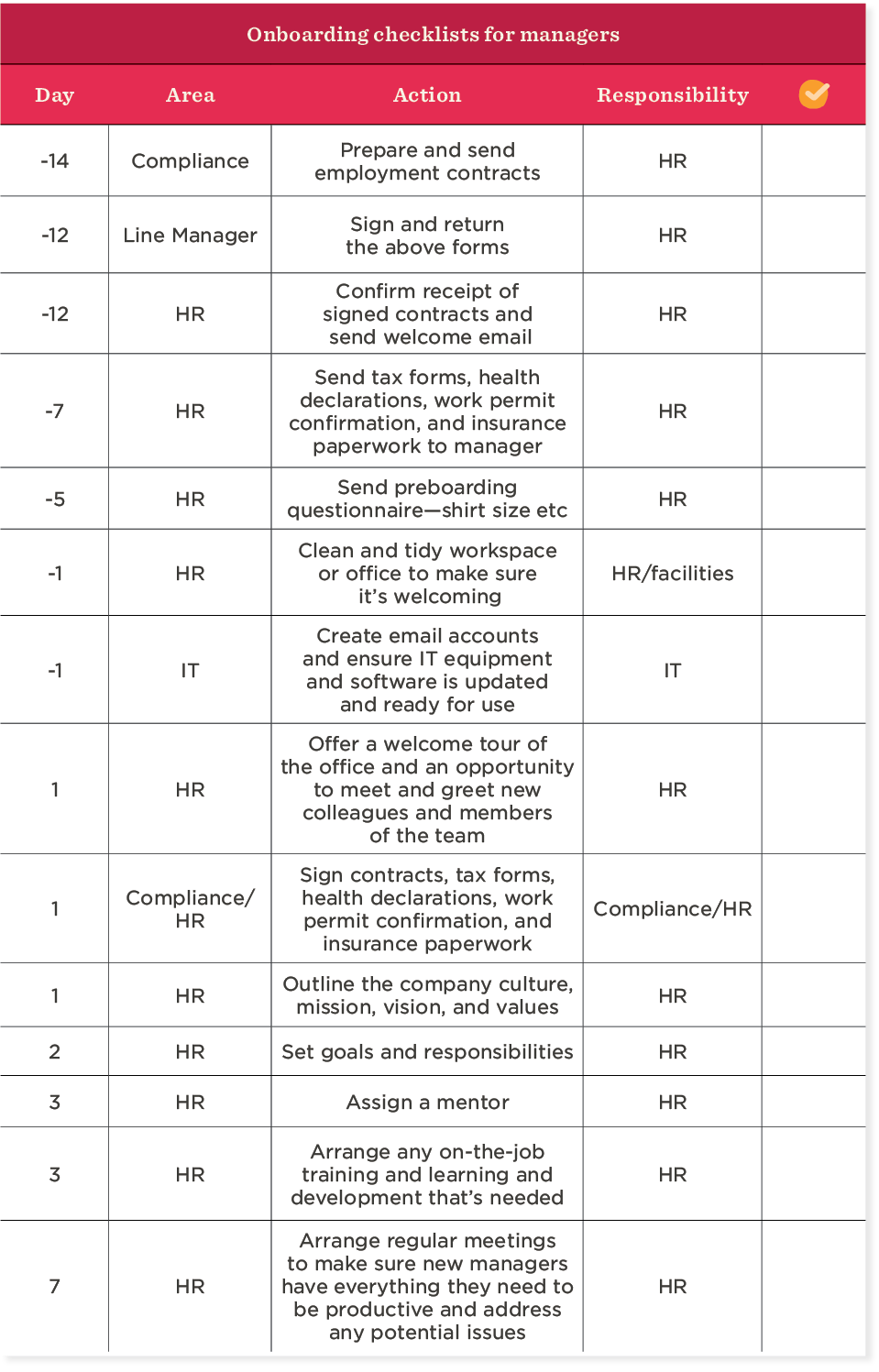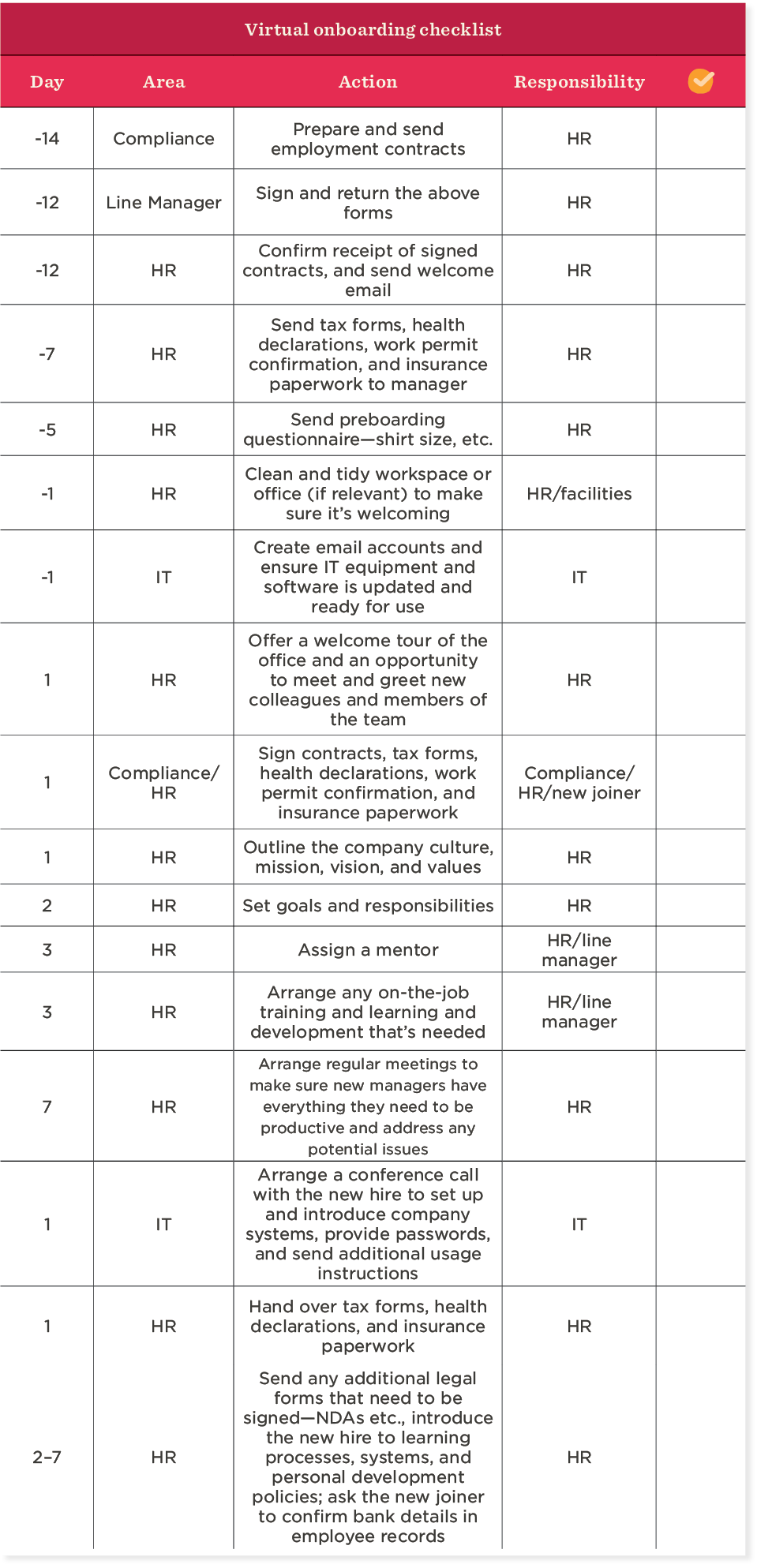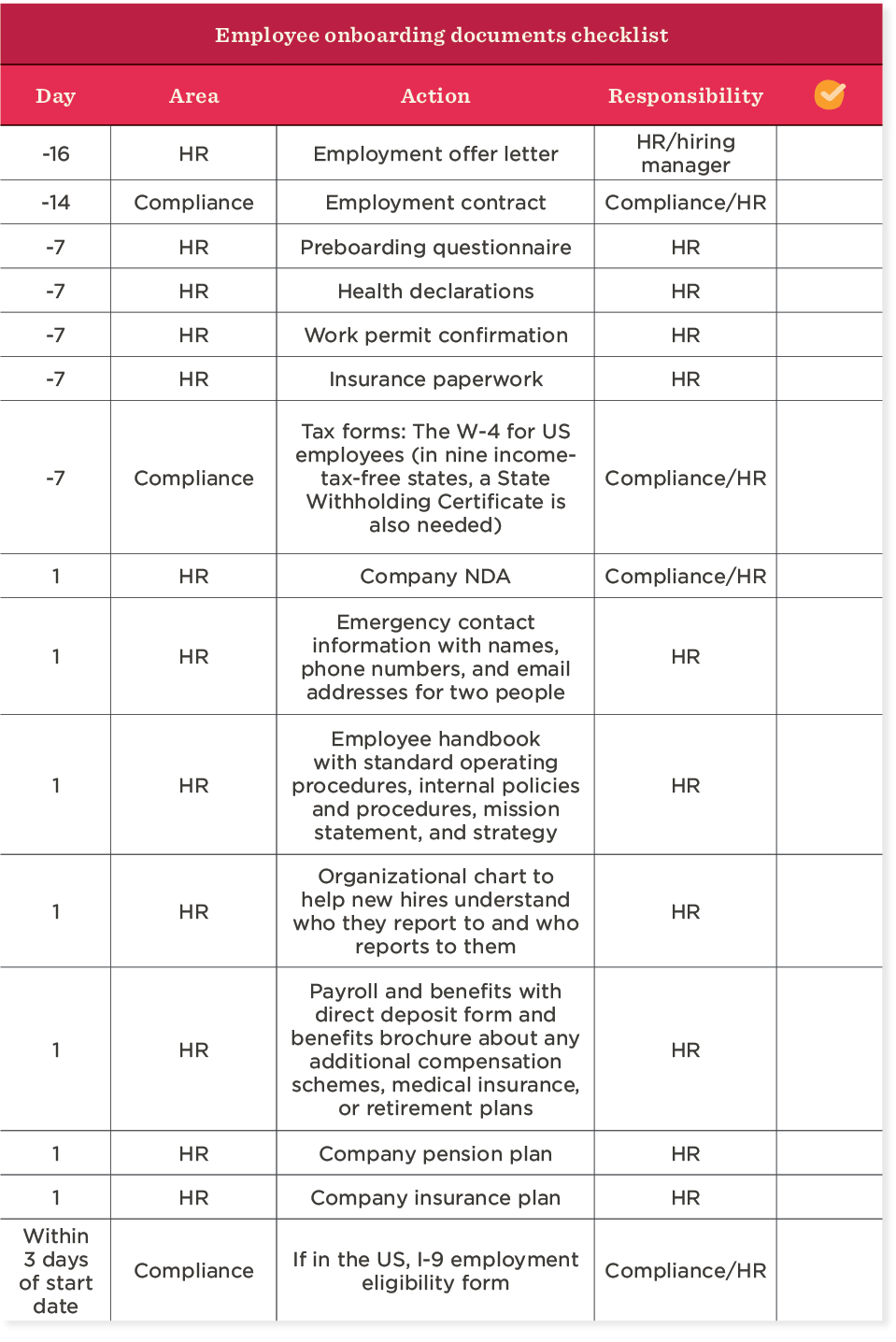Welcoming a new team member can be exciting but also overwhelming. Following onboarding best practices requires careful planning and organization.
HR teams can use an employee onboarding checklist to follow each stage of the onboarding process correctly. A great onboarding checklist merges HR and compliance efforts with management tasks and technology set-up to create an optimized experience for the new joiner and the organization.
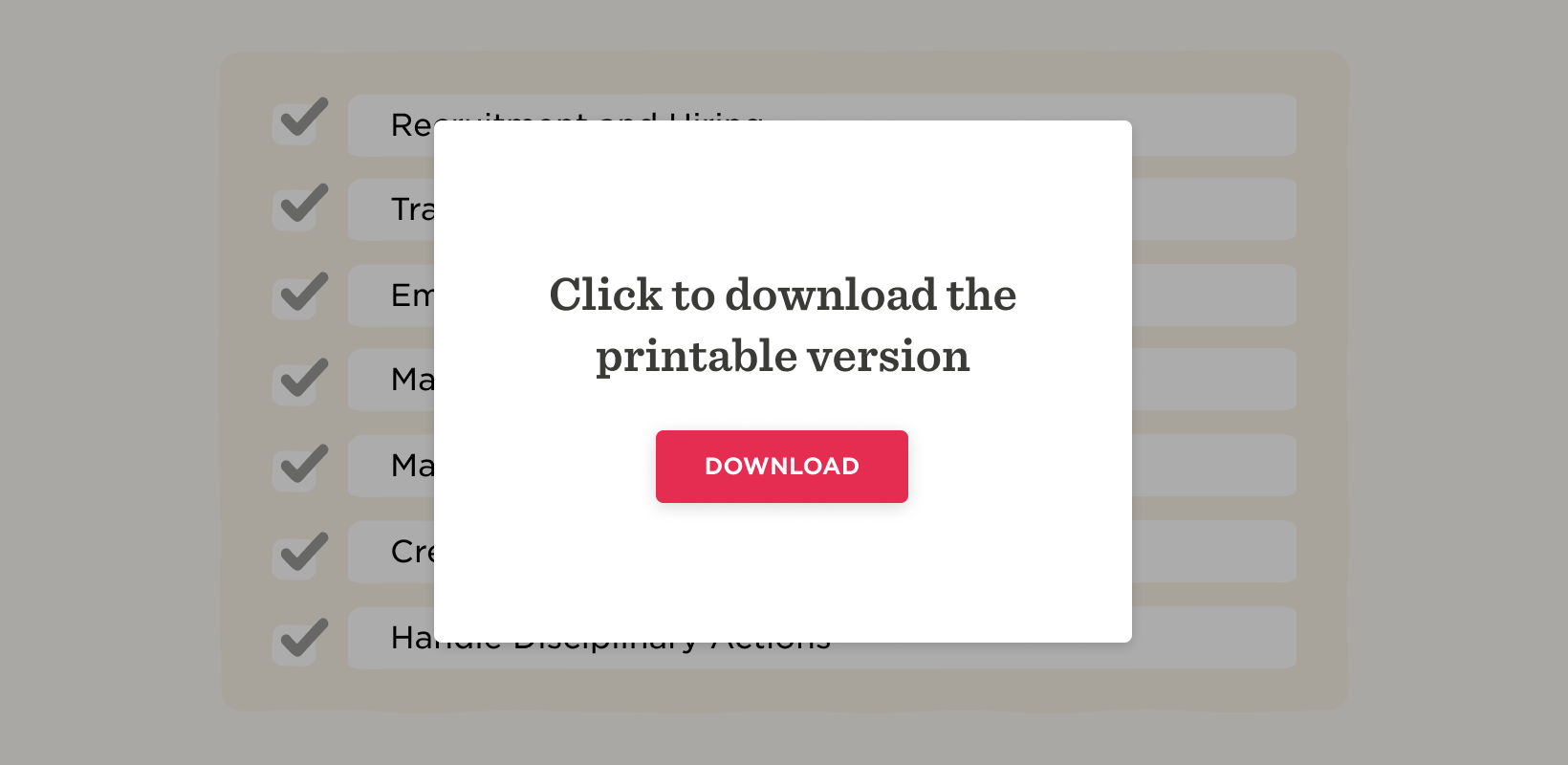
<<Download our onboarding checklists and put a solid procedure in place.>>
What is employee onboarding?
The Oxford English Dictionary defines onboarding as, “The action or process of integrating a new employee into an organization.”
A successful onboarding process starts when the chosen candidate accepts the job offer. This marks the beginning of the employer’s and new joiner’s journey together.
While some businesses adopt a day-long onboarding schedule, others integrate their new hires into the team with preboarding and onboarding processes that extend well beyond the new hire’s first 90 days of employment.
A good employee onboarding process retains talent, increases engagement, and fosters a productive workforce.
What are employee onboarding checklists?
HR teams can use employee onboarding checklists to ensure new hires transition smoothly into their roles. These checklists outline important tasks like completing necessary paperwork, setting up workstations, introducing team members, and providing access to tools and resources.
For the business, an onboarding checklist ensures compliance with legal regulations. It also provides a system of fairness and equality so one new hire isn’t left behind if another has a more diligent, hands-on manager. This means that new hires can start being productive and contributing to the company soon after they join.
For HR professionals, an onboarding process checklist reduces the admin associated with welcoming new people to the company—a particularly significant benefit in fast-growing companies that hire new people on a weekly basis. When they know that a plan to support new hires is in place, HR professionals can focus their time and attention on other business areas.
For new hires, a checklist creates consistency and nurtures a genuine feeling of belonging from day one. With the support they need to start work and focus from the outset, new people can quickly develop a sense of commitment to their new employer and contribute to the bottom line.
HR teams can follow these onboarding checklists to make sure new people feel welcomed, informed, and ready to contribute effectively from day one.
<<Download our onboarding checklists and put a solid procedure in place.>>
Why streamlined onboarding is important
The saying, “you never get a second chance to make a good first impression” is as true for companies as it is for people. HR leaders who understand this—and optimize their onboarding to create a positive first impression with new hires—can reap a wealth of benefits, including improved cultural inclusion and increased engagement.
Improved retention
HR leaders who introduce structured onboarding can avoid the high costs, lost productivity, and potential damage to company culture that can result when people leave their jobs.
People who experienced a good onboarding process feel 18 times more committed to their new organization.
Increased productivity
Whether new hires are direct replacements for leavers or they’ve been hired to fill new roles, it takes time for new people to get up to speed. Proper onboarding can help with that. People with a formal onboarding process are 70 percent more productive than those who go without.
Better understanding of company culture
Each company has its unique culture. A streamlined onboarding process allows new joiners to understand the values of the company they work for and the people they work with.
Benefits of using employee onboarding checklists
A good onboarding process covers many areas, including compliance, logistics, management, training, and cultural engagement. Your organization may require additional sections that are particular to your business or industry.
<<Download these onboarding checklists and put a solid procedure in place.>>
1. Compliance
You can usually complete most legal and compliance tasks remotely before the new joiner’s first day on the job. Using a legal and HR compliance checklist can help the new joiner complete their:
- Employment contract review
- Health and safety training
- Employee handbook review
- Additional legal documents relevant to your business (e.g., non-disclosure agreements)
2. Logistics
Solid logistics ensure your new hire arrives at the right place, on time, and with the tools they need to start off on the right foot. The best onboarding workflows include:
- Sharing locations and directions so new joiners know where to go
- Ensuring ease of access if the person has a disability
- Setting up their phone
- Providing access to the employee directory
- Providing a computer or helping them set up their own device for your systems
- Giving them internet access
- Setting them up for payroll
3. Management
Hiring managers play a critical role in supporting new joiners as they learn how to perform key tasks. They can use a detailed checklist to ensure they’re:
- Providing relevant company and team information
- Explaining company and team processes (e.g., booking meeting rooms or booking holidays)
- Setting objectives and goals for 30, 60, and 90 days
4. Training
The majority of new hires will need some training on arrival, so it’s best to consistently provide learning opportunities that will bring them up to speed quickly:
- Introducing learning processes, systems, and policies so the new person knows what to expect
- Carrying out skills assessments to gauge knowledge and ability
- Setting up supervision and mentoring
- Beginning role-specific training
5. Cultural Engagement
HR leaders can use an employee onboarding checklist to intentionally lay the groundwork for cultural engagement. To get this right from day one, you can:
- Explain company culture and values, so the new person understands your “why”
- Set up meetings with their direct team and other people they’ll work closely with regularly
- Facilitate meetings with key people in the company, such as department heads, members of the management team, and IT support
- Help the new starter foster personal connections with the team based on work and personal interests
- Organize welcome events such as new-starter meetings with the CEO, after-work drinks, and welcome lunches
<<Download these onboarding checklists to keep everything in one place.>>
What to include in your employee onboarding checklist
Hiring managers can use an onboarding checklist to guide new people through their first days and months at a company.
The goal is to inform new team members about what to expect in the early days and what the company expects in the long run.
Finalizing the recruitment process
Ensure complete clarity on all terms of employment and complete negotiations. Confirm all necessary paperwork is signed and set a start date.
Setting up accounts and devices
Begin account set-up before the new joiner’s start date to minimize unnecessary wait time and address technical issues early on. This way, you can sort out potential issues before they interfere with the rest of the onboarding process.
Preparing documentation
Compile all onboarding paperwork and documentation that the new joiner will need to complete. These can include your company’s performance management practices, an employee handbook, a staff directory, and your attendance policy.
Organizing your workspace (if applicable)
Greet your new joiner with a beautiful and organized workspace. A few minutes of thoughtful preparation goes a long way in making new joiners feel welcome.
Scheduling new hire orientation
Coordinate a time for new hire orientation, where you can review the basics of company culture and expectations, complete paperwork like tax forms and benefits enrollment, and share information about team structure.
You can also answer questions to help the new joiner begin on the right foot.
Giving an office tour
If your company has an office, show the new joiner around.
A tour might include locations of the bathrooms, cafeterias, break spaces, and outdoor areas, along with introducing key team members.
If your company works remotely, you can still support the new hire. Virtual tours can include shared drives, key communication platforms, and where to find team assets.
Informing team members and assigning a mentor
Build excitement among the team and prepare members to welcome the new joiner. If appropriate, assign a mentor to help the new person navigate the ins and outs of the team and culture.
Introducing company culture
Make time to address specific factors of your company culture. Whether you have a strict dress code, a relaxed Friday schedule, or a monthly team lunch, provide details your company handbook may not cover.
Discussing expectations
It’s easy to assume new people will understand the expectations of a workplace based on their previous experience, but every organization is different. Make expectations clear to avoid confusion.
<<Download these onboarding checklists and put a solid procedure in place.>>
New employee onboarding checklists
Use these onboarding checklists to guide your workflows as you welcome new joiners to the company.
1. Onboarding checklist for the week before
HR leaders can use this onboarding checklist the week before a new joiner’s start date to thoroughly prepare for their welcome.
What this checklist includes:
- Compliance: Get employment contracts in order.
- Culture: Schedule welcome activities with the team, like Friday drinks or a first-day lunch with the team.
- Logistics: Set up all necessary accounts, distribution lists, and calendar access. If applicable, clean and organize the new joiner’s desk.
- Management: Send an introductory email and schedule a date for orientation.
<<Download this onboarding checklist.>>
2. Onboarding checklist for the first day
The first day can be a whirlwind, so HR leaders can use this onboarding checklist to keep everything in order.
What this checklist includes:
- Compliance: Set the new joiner up in the HR system, provide all necessary checklists, and organize health and safety training.
- Culture: Schedule introductory meetings for the new joiner with each of their direct team members.
- Logistics: Set the new joiner up in the payroll system and provide internet access.
- Management: Explain basic procedures like how to book a meeting room or request time off. Give an overview of each direct team member’s key role.
<<Download this onboarding checklist.>>
3. Onboarding checklist for the first week
You can use this onboarding checklist for the first week of the new joiner’s tenure to help them steadily ramp up and learn company processes and expectations.
What this checklist includes:
- Compliance: Bring the new person up to speed on key company policies and enroll them in the pension plan
- Culture: Schedule meetings between the new joiner and relevant department heads and management team members
- Logistics: Finish all staff benefit enrollment steps
- Management: Set objectives and goals for the next 30, 60, and 90 days
<<Download this onboarding checklist.>>
4. 30-day onboarding checklist
HR leaders and managers can use this checklist as a guide to make new team members’ first month as smooth as possible.
What this checklist includes:
- Compliance: Follow up on incomplete contracts, policy signatures, and safety training.
- Culture: Introduce the new joiner to adjacent teams and additional team members they didn’t meet in week one. Include them in meetings relevant to their future projects, even if they don’t have assignments yet.
- Logistics: Set up training for software and tools the team uses. Provide materials that review company functions and goals.
- Management: Schedule weekly one-on-one meetings to address ongoing questions and concerns. On day 30, meet to touch base on the 30-day goals set in week one.
<<Download this onboarding checklist.>>
5. 90-day onboarding checklist
By the time three months have passed, new joiners should feel comfortable on the team and perform expected duties smoothly. To complete the transition, you can use this 90-day employee onboarding checklist.
What this checklist includes:
- Compliance: Send necessary tax forms and stay up-to-date on new safety training.
- Culture: Gather feedback on the onboarding process and address ongoing questions.
- Logistics: Answer additional questions about team workflows, additional tools, and staff roles as specific situations arise.
- Management: Identify gaps in expected skills or training, and create plans to support these needs, and communicate goals. Bring the new joiner in on projects and assign meaningful deliverables.
<<Download this onboarding checklist.>>
6. Onboarding checklists for managers
Onboarding plays a key role in workforce management. Managers can use this checklist to stay organized as they welcome new joiners.
What this checklist includes:
- HR: Facilitate a welcome tour, send a preboarding questionnaire, and arrange job training.
- Compliance: Make sure the new person has signed and submitted all employment contracts, tax forms, health declarations, permits, insurance, and other paperwork.
- Logistics: Make a welcome kit and give the new joiner a thorough tour of the physical office space and the technology they’ll use.
- Management: Communicate with the new joiner about ongoing questions, concerns, and outstanding checklist items. Set frequent meetings for the first month.
<<Download this onboarding checklist.>>
7. Virtual onboarding checklist
Use a virtual onboarding checklist to stay organized as you onboard new joiners remotely. This process involves some additional steps that need early action.
What this checklist includes:
- HR: Confirm that all contracts and signatures come in correctly and send a welcome email
- New joiner: Fill out questionnaires and attend all conference calls
- Compliance: Prepare and send e-sign versions of all contracts, health declarations, work permit confirmations and disclosures
- Logistics: Order and ship all office hardware and computer equipment and schedule calls between the new person and IT
- Management: Send an email to the team welcoming the new joiner and discuss communication preferences
<<Download this onboarding checklist.>>
8. Employee onboarding documents checklist
The onboarding process can involve a lot of paperwork. HR leaders can use this checklist to ensure a smooth and seamless experience for everyone involved.
What this checklist includes:
- Compliance: New joiners need to fill out compliance documents, including the employment contract, I-9 eligibility form, W-4 tax form, and NDAs (or the equivalent, depending on location)
- Culture: Send a preboarding questionnaire to get to know the new joiner and collect details for future culture events
- Logistics: Facilitate completion of the direct deposit form and send all information on payroll, benefits, pension, and insurance
- Management: Send and review the offer of employment, health declarations, employee handbook, organizational chart, and emergency contact lists
<<Download all these onboarding checklists and put a solid procedure in place.>>
9. New employee welcome email templates
A nice welcome and introduction goes a long way toward helping a new person to fit in. You can use onboarding email templates to help.
Here are two essential emails that you can copy and paste. Just customize the parts in brackets:
Next steps after employee onboarding
Completing an onboarding checklist doesn’t necessarily translate into a successful onboarding.
After onboarding, how do you transition your new joiner to engage at the same level as other people in your team? Do you have a plan?
Find the right time
Review your team’s regular cycle of activities to determine the best time to integrate your new hire. For instance, if they start in May and annual performance management reviews are in June, it’s best to exclude them from that year’s review.
Let them know what’s expected
Communicate early and often about company procedures and expectations.
A short email with a list or a guide in your employee HR documents file will allow them to refer back to it. After all, what’s second nature to you could be completely new to them.
Touch base throughout the first month, 90 days, and year
Clear communication and ongoing support benefit team dynamics and overall performance. Schedule regular meetings to address goals, questions, and concerns to keep everything running smoothly.
Get feedback on the onboarding process
Ask for candid feedback about the onboarding process from your new joiner. Gather insights about the logistics, support, and learning curve so you can improve the process for each new person.
Recommended For Further Reading
Streamline onboarding with free onboarding checklists
Employee onboarding checklists can simplify the complexities of onboarding. Instead of feeling overwhelmed by the excitement of welcoming a new team member, HR leaders can follow these organized checklists to lead with confidence and integrate new people into the team smoothly.
<<Download all these onboarding checklists and integrate new joiners seamlessly.>>
Meet Bob
At HiBob, we’ve built a modern HR platform designed for modern business needs—today and beyond.
An HR platform such as Bob offers a one-stop-shop for all things HR. It sits at the center of your HR ecosystem, is fully customizable, and grows with your organization.
For HR
It delivers automation for many common processes, allows greater oversight and visibility of the business, and centralizes all people data in a secure, user-friendly environment.
For managers
It provides access to data and insights to help them lead more effectively and streamline processes.
For employees
It’s the tools and information they need to connect, develop, and grow throughout their journey.
In a short time, Bob can be deployed to enable communication, collaboration, and connectivity that drives stronger engagement, productivity, and business outcomes.

